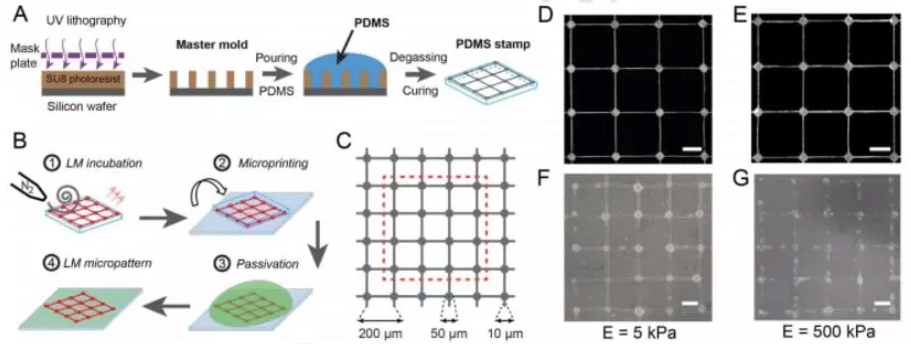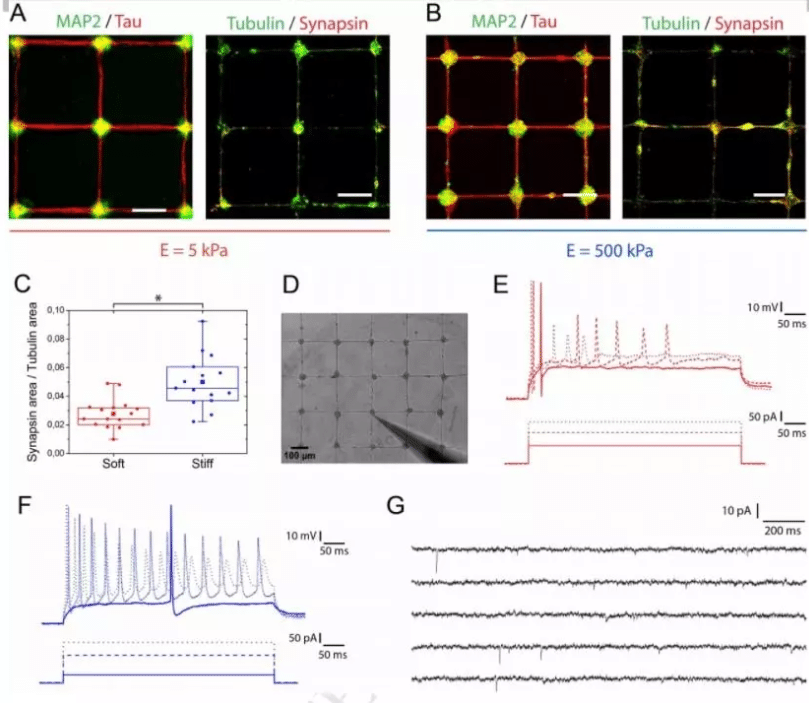> NEURAL TISSUE ENGINEERING
Matrix stiffness modulates formation and activity of neuronal networks
> NEURAL TISSUE ENGINEERING
Matrix stiffness modulates formation and activity of neuronal networks
Mechanical properties of the culture matrix can modulate important neuronal functions such as growth, extension, branching and activity. Microprinted neuronal networks was already achieved successfully on different surfaces such as glass, silicon substrates or single-layered graphene substrates but the effect of the surface rigidity on neuronal networks remained unknown. Here this study describes a robust and very accessible way to produce mature neuronal cortical networks, with a controlled architecture on different matrix stiffnesses, without affecting cell viability. This tool would be usefull to better explore brain injuries and degenerative diseases.

KeyWords: Mechanotaxis, matrix stiffness, cortical neurons, neuronal network,synapse connectivity, action potential

Protein micropatterns guide neuronal assembly.
(A) Preparation of microstamps in polydimethylsiloxane (PDMS). (B) PDMS microstamps were incubated with a solution of poly-L-lysine (PLL) and laminin (LM), dried with nitrogen and stamped to obtain (C) well-defined LM networks on (D) soft hydroxy-PAAm hydrogels (E=5 kPa) mimicking brain-like stifness (brain tissue has an elastic modulus of 0.1–5 kPa) and (E) stiff PDMS surfaces (E=500 kPa). Primary rat cortical neurons (RCN) prepared from the cortex of day-18 rat embryos were suspended in a culture medium supplemented with antibiotic, GlutaMAX-I and nerve growth factor. RCN were seeded on microprinted subtrates at a density of 50,000 cells/cm2 and incubated under standard conditions (37°C, 5% CO2). DIC images of neuronal networks obtained after 9 days of in vitro growth (DIV) of RCN on (F) soft and (G) stiff microprinted surfaces. Cell bodies of primary cortical neurons gradually accumulate in circular islands, whereas axonal extensions spread on linear tracks to connect circular islands. No statistical differences of protein density were found between soft and stiff matrices.
Cortical neuronal networks designed on stiff substrates maintained their spatial structures for up to 21 days in vitro without altering their spatial organization and functional activity. By confining soma location and neurite elongation to a predefined pattern, this method opens a way to generate reproducible and standardized neuronal network, controlling the number of cell interactions.
Interestingly, cortical neurons can not only sense mechanical cues from their microenvironment, but also integrate these parameters into synapse connectivity and electrophysiological activity. Migration of cortical neurons is enhanced on soft substrates, leading to a faster formation of neuronal network, whereas synaptic density in cortical neuronal networks is enhanced on stiff substrates. In fact, networks on soft substrates were characterized by a lower number of action potentials.

Modulation of the assembly dynamics and the functional activity of cortical neurons by tuning matrix stiffness and surface patterning.
Epifluorescent images of cortical neuronal networks grown on soft and stiff surfaces and immunostained for MAP2/Tau and βIII- tubulin/synapsin. The ratio of synapsin/tubulin areas was quantified in NIS Elements Advanced Research (v4.5, Nikon, Japan)(Lantoine et al., 2016). (D) Patch clamp experiment performed on a micropatterned neuronal network. Action potential firing was analyzed on (E) soft and (F) stiff matrices. Intrinsic excitability was investigated by injecting a 500 ms-/40pA hyperpolarizing pulse followed by a 500 ms/0-200pA (10pA increments) depolarizing pulse. The number of action potentials was counted up on each depolarizing step. (G) record of miniature synaptic currents in neuronal networks grown on stiff surfaces under voltage- clamp (-65 mV/13s).
Matrix stiffness is a key parameter to modulate the growth dynamics, synaptic density and electrophysiological activity of cortical neuronal networks. These results demonstrate the possibility to modulate the assembly dynamics and the functional activity of cortical neurons by tuning matrix stiffness and surface patterning. By using neuronal networks on compliant substrates, future work would focus on elucidating the role of the matrix stiffness on the balance of excitatory versus inhibitory receptors and the possible role for tension forces in neuronal and network function.
Reference: Matrix stiffness modulates formation and activity of neuronal networks of controlled architectures.
Lantoine J et al., 2016 – j.biomaterials